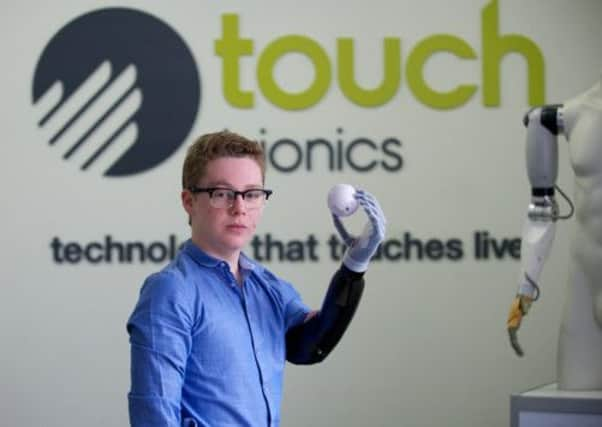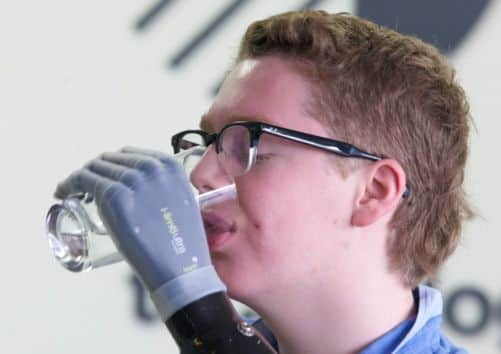Teenager who lost limbs is fitted with bionic hand


• Patrick Kane, 16, was fitted with the i-limb ultra revolution
• The techonology was developed by Touch Bionics based in Livingston
Advertisement
Hide AdAdvertisement
Hide Ad• Patrick says he can’t imagine living without his i-limb now


• The new technology can be controlled by muscle contraction or a mobile phone app.
Patrick Kane’s i-Limb Ultra Revolution bionic hand, produced by Livingston-based Touch Bionics, features a powered rotating thumb, 24 grip options and is the first upper- limb prothesis that can be controlled via a mobile application.
The mobile control application, which is compatible with the latest Apple products, including the iPhone, will allow Patrick, 16, to type, hold papers and use a computer mouse via a single screen tap.
He will also be able to cut up his own food and tie his shoelaces for the first time using his new hand, which has already featured in a music video by will.i.am and Britney Spears.
Patrick was nine months old when he spent three months in intensive care after falling ill with meningococcal septicaemia. Doctors amputated all the fingers from his left hand, part of each finger on his right hand, and his right leg below the knee.
Yesterday, Patrick, who tracked down Touch Bionics in 2010 after spotting an earlier version of the Ultra on the internet, showed off his prowess with the latest cutting-edge bionic hand, complete with an on-trend black sleeve.
Describing the difference it has made to his life, Patrick said: “I used to be a little bit embarrassed asking people for help. It has made such a subtle difference in so many ways.
Advertisement
Hide AdAdvertisement
Hide Ad“When I was opening a water bottle, I used to have to clamp it between my thighs, then use both my stump and left hand to twist it in order to open it. That worked, but it was a little bit clumsy.”
He added: “I’m very independent and would always have found a way, but now I can do things the way they are meant to be done.”
Patrick was fitted with the earlier version of the i-Limb Ultra in 2010. He travelled to Scotland and underwent a week’s training in how to operate it.
Patrick, a pupil at University College School in Hampstead, London, said he had deliberately chosen a black sleeve for his new limb.
“When I’m meeting new people, it’s a great conversation starter. It interests my friends greatly. It’s been very well received. The first time I wore it
I nearly ran out of batteries with shaking hands with over 125 boys.”
Patrick, whose prosthetic hand was paid for by his family, said one of his proudest moments was being a torch- bearer in Trafalgar Square for the London Olympics.
Ian Stevens, chief executive officer of Touch Bionics, said the new limb, which is not available on the NHS and costs between £25,000-£80,000, could greatly enhance everyday life.
Advertisement
Hide AdAdvertisement
Hide Ad“We believe the i-Limb Ultra Revolution offers unparalleled dexterity and control, enabling wearers to more easily perform activities of daily living and thus increase their quality of life.”
Richard Morrison, the chief executive officer of the Limbless Association, said the NHS provided only non-functioning cosmetic or “pincer” versions of prosthesis, but technological advances had raised the profile of amputation.
He said: “Years ago, when someone had an amputation, it would have been, ‘Oh dear, that’s a shame, hide it under a cover’.
“But the downside is that people assume you can do more than you can.
“Paralympians have trained to do exceptional things, but the situation is different for day-to-day issues for someone in their fifties who has diabetes.”